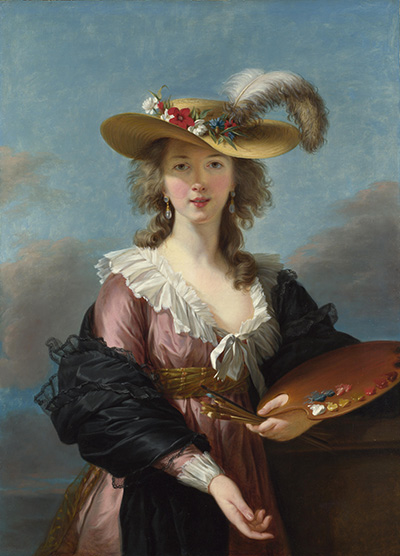Élisabeth Louise Vigée Le Brun was a famous French portrait painter from the 18th and 19th century with a style that most consider Neoclassical. Her subjects were almost exclusively women. She is best known for serving Marie Antoinette.
The artist was highly regarded by both fellow artists as well as the major European art institutions of her period, often compared to the old masters as well as regularly being featured in major European art galleries and museums.
She was a highly prolific artist who left behind over 800 paintings alone, and was considered a fine exponent of both portrait and landscape art. Élisabeth can be considered one of the most impactful female painters in history, helping to persuade many within the male-dominated art world of the merits of women artists.
Early Life
Élisabeth Louise Vigée Le Brun was born in Paris on the 16th of April, 1755. Her mother, Jeanne, was from a humble background but her father, Louis Vigée, was a highly skilled artist and member of the Paris-based Académie de Saint-Luc. From the moment his daughter showed an interest in art, he immediately encouraged and supported her, providing Élisabeth with a strong grounding in the visual arts from a young age.
Sadly, her father died when she was only twelve years old and she would grow to despise her step-father, Jacques-François Le Sèvre. Despite being around her father for only a relatively short part of her life, Élisabeth followed a similar artistic route in terms of focusing most on portraiture. She also surrounded herself with more experienced portrait artists who she met in Paris and this helped to bring new opportunities to her career.
She quickly turned professional and was accepted into the Académie de Saint-Luc as she started to strengthen her reputation. She would marry Jean-Baptiste-Pierre Le Brun, a painter and art dealer, in January 1776 which further solidified her status, helping to bring a consistent flow of donors as well as financial stability to her for the first time.
Just a few years into their marriage they would have a daughter, Jeanne Lucie Louise, and shortly afterwards would set off on a tour of the low countries, which brought some of the finest European artists outside of France and Italy to their attention. This impacted Élisabeth’s work in a positive manner, encouraging her to experiment with some of these alternative techniques.
Mature Period
The 1780s marked perhaps the pinnacle of the artist’s career as she developed a working relationship with Marie Antoinette. Although Élisabeth was never appointed as the official painter of the monarch, having amassed around thirty portraits of this famous historical figure over the period of several years, many regarded her as such. It is also this body of work which continues to draw attention to her oeuvre, even though it is actually much larger and more diverse than this small selection might suggest.
The French Revolution of 1789–1799 placed the artist in grave danger, because of her much-reported association with Marie Antoinette. She decided it best to leave Paris and headed to Italy in 1789, before later moving on to Austria (1792–1795), Russia (1795–1801) and Germany (1801). She was active in various locations around Italy, producing work in all of Parma, Rome and Naples.
Perhaps her highlight in this period was Emma Hamilton as the Persian Sibyl, 1792, an artwork which the artist herself was also particularly proud of. Her appearance in this wide spread of nations also helped to widen the coverage of her career, which in later centuries has greatly benefited her legacy.
The artist was finally able to return to Paris in January 1802 after many years in self-imposed exile. It should have been a joyous occasion, returning home after achieving so much all across Europe but sadly the artist was never comfortable in the new Paris which had formed after the revolution and perhaps wished she had never returned.
She found safety in England for a period, and was given protection by a number of highly connected donors who allowed her to stay even though there was a continued conflict between England and her native France. Some years later she would finally return to France for good, living there until her death.
Technique and Style
Her artistic style is best remembered for its light touch, with delicate brushwork producing refined portraits which would perfectly capture the essence of each sitter. Her portraits appeared less formal when compared to other portrait painters in the early 19th century, which drew criticism from some, but praise from others.
Her status as a female painter may have helped to build a rapport with her subjects, which would then bring out their personalities within the final piece. Her female sitters would also have felt confident that Élisabeth would portray them in a positive, flattering manner and would better understand their own mindset.
Death
The artist died in Paris on the 30th of March 1842, aged 86. She was buried in Louveciennes, Île-de-France, where she had lived during the latter part of her life, as she sought refuge from the hustle and bustle of Parisian life. She is not believed to have exhibited work after the 1820s but is likely to have still produced the occasional painting right up to her death.
Legacy
Élisabeth Louise Vigée Le Brun was a true master of portrait painting and achieved considerable recognition within her own lifetime. Any barriers that female painters faced at this time were of little concern to this strong willed and highly skilled Parisian painter. Her spell as portrait painter to Marie Antoinette ensures that her legacy will likely never be forgotten, but in truth her output was much larger and more varied than that single series of paintings.
She also achieved success in a great number of countries, due to her exile from France, and this helped to strengthen her artistic legacy, with many of her paintings still on display in these other countries, many centuries later.




